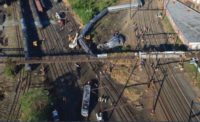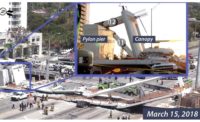The National Transportation Safety Board has determined that several factors combined to be the probable cause of a fatal 2017 Amtrak derailment in DuPont, Wash., including track owner Sound Transit’s failure to take steps to address the dangerous curve where the train derailed—a segment that lacked an operational Positive Train Control system. The board also cited the engineer’s excessive speed as he entered the curve and his lack of training on that section of track and the type of locomotive he was operating.
The four-member board voted unanimously on May 21 to endorse the findings of its staff that investigated the accident and 26 new safety recommendations, and several reiterated ones, for the U.S. Department of Transportation/Federal Railroad Administration, Sound Transit, Amtrak and other organizations.
The NTSB also said a contributing factor involved in the accident was the Washington State Dept. of Transportation's decision to begin revenue service on the line without the assurance that safety certification and verification had been done to the level contained in a preliminary hazard assessment.
Moreover, the board said a factor that contributed to the accident's severity was the FRA's decision to use a "grandfathering" provision to allow use of railcars that didn't meet strength requirements set by regulation for revenue passenger service. NTSB said that ended up leading to "passenger ejections, injuries and fatalties."
Board chairman Robert L. Sumwalt underlined the importance of positive train control (PTC), a system of wayside and in-locomotive equipment and technology that aims to prevent excessive train speed and derailments.
Sumwalt said that since 2013, the NTSB has investigated three fatal derailments involving high speed, including the one in Washington. "All three have the same thing in common: each could have been prevented by Positive Train Control," he added.
He said that starting revenue service on the track segment before PTC was in operation there "set up the engineer to fail."
On Dec. 18, 2017, Amtrak’s Cascades Train number 501 was on its initial run on a route from Seattle to Portland, Ore., when it went off the rails as it entered a curve at a speed of about 78 mph, more than twice its posted 30 mph speed.
NTSB said the lead locomotive and four cars dropped onto Interstate 5, hitting eight vehicles. Three passengers aboard the train were killed and 57 passengers and crew members and eight in highway vehicles were injured.
NTSB Recommendations
Among the board's many recommendations, it called on FRA to bar passenger service on "new, refurbished or updated" track segments unless PTC is implemented there.
It also recommended that FRA to "compel" all intercity passenger and commuter rail lines to meet long-pending requirements of adopting and implementing requirements for emergency lighting to let passengers, crew members and first responders move safely through cars after accidents.
The board also said the Washington State DOT should discontinue the type of trainset involved in the accident "as soon as possible." The state DOT said in a May 22 statement that it will work with Amtrak to follow the NTSB recommendation and take the trainsets out of service as soon as possible.
Positive Train Control
In the 2008 Rail Safety Improvement Act, Congress mandated PTC installation, by Dec. 31, 2015. But as that date neared, it became clear that many railroads wouldn’t meet the deadline. In October 2015, Congress approved an an extension to Dec. 31, 2018. It also allowed for an extension of a further two years for having PTC fully operational, if they met several conditions, including having all of the needed PTC equipment in place as of yearend 2018.
FRA reported on Feb. 15 that four railroads had fully implemented PTC on their main lines as of last Dec. 31 They are the New York-New Jersey Port Authority Trans-Hudson, North County Transit District in North San Diego County, Calif., Portland & Western Railroad in Oregon and Southern California Regional Rail Authority Metrolink system, based in Los Angeles.
Thirty-three other railroads formally requested FRA to approve an “alternate schedule”, or exgtensin for PTC implementation. As of Feb. 11, FRA had approved 25 of those requests.
Amtrak, Sound Transit, FRA Comments
Amtrak spokesperson Olivia Irvin said in a statement, "We remain deeply saddened by the loss of life and injuries ue to this tragic event."
Irvin said, “We continue to cooperate with the NTSB and will work with them to address their recommendations.” She added, “Amtrak remains committed to continuouslyi mproving safety for both our customers and employees.”
She said the railroad has taken more than a dozen safety-related actions, including being the first railroad to submit to FRA a System Safety Program plan, a step it took last Nov. 1, and developing a plan to improve use of upgraded simulators in training and certifying employees.
Sound Transit said in a statement that the accident “was a terrible tragedy that sears in the memory of all of us….” It also said it has taken actions in advance of the NTSB recommendations, including instituting a new graduated speed limit on the stretch leading into the curve, from 79 mph to 50 mph to 30 mph.
The agency also has installed additional signs and and added communication requirements for its crews. It added that “PTC is now fully operational in the corridor.”
Sound Transit said that although it “does not operate any service in the segment of track where the accident took place, as owner of the track we commit to closely reviewing the NTSB’s report and implementing recommendations” working with Amtrak, Washington State DOT and FRA.
An FRA spokesperson said in a May 22 statement that the agency "takes all NTSB recommendations very seriously and we will carefully review them and directly address each one in our formal response within the next 90 days."





Post a comment to this article
Report Abusive Comment